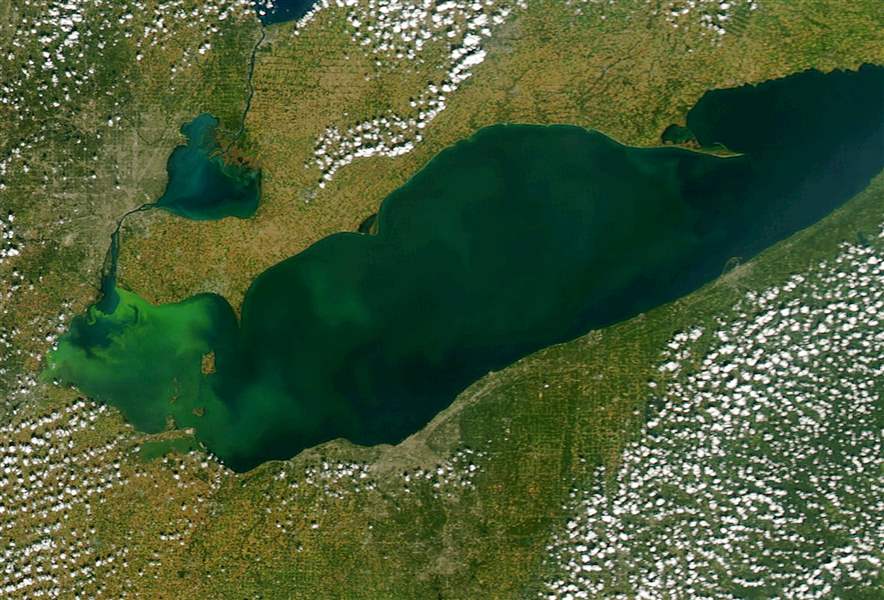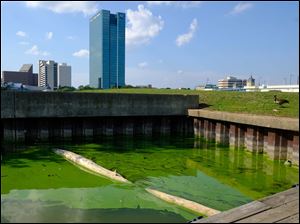
New paper on ag. practices presented at Lake Erie Foundation event
12/11/2017
Satellite photo of Lake Erie algae taken on Sept. 26.
NOAA CoastWatch

An algae bloom from Lake Erie on Sept. 21.
LAKESIDE, Ohio — A scientific paper written as a blueprint for addressing Lake Erie algae calls on the agricultural industry to focus more on injecting manure and other fertilizers three to five inches underground and limiting phosphorus applications to 50 parts per million or less.
That’s a concentration the state of Ohio currently has as a limit for crop fields. But livestock operations are allowed to apply as much as 150 ppm, meaning the paper’s suggested limit could pose a challenge for some facilities.
While still recognizing the value of other more traditional best management practices, such as windbreaks, buffer strips and cover crops, the research document claims Ohio could achieve its goal of reducing phosphorus loading into western Lake Erie by 40 percent if all farmers embraced those two simple concepts.
The so-called “white paper” was presented to 60 people at a Lake Erie Foundation event inside Lakeside’s Wesley Lodge by Jeff Reutter, special adviser for Ohio Sea Grant and Ohio State University's Stone Laboratory. He said scientists have found soil at some animal farms across the state to be as high as 1,000 ppm and even 2,000 ppm.
“We can’t identify those fields now because of privacy laws and that’s unfortunate,” he said.
Mr. Reutter told The Blade in a follow-up interview those unusually high concentrations are at “legacy fields” that preceded many of today’s operations, and are not indicative of modern practices.
The paper raised questions about where the state could best put its attention: It found that 97 percent of the acreage draining into the western Lake Erie watershed belongs to farms 50 acres or larger. Policymakers, therefore, might want to focus more on larger operations, Mr. Reutter said.
The paper distills known data about the runoff issue into policy recommendations aimed at helping Ohio achieve its goal of reducing phosphorus loading into western Lake Erie 40 percent by 2025. Michigan and Ontario also have committed to that goal.
Ohio Sen. Randy Gardner (R., Bowling Green) said he found four recommendations to be particularly useful. Those include application rates based on soil tests; the need for more fertilizer injection instead of surface application; more efforts to control erosion, and better ways to control drainage.
He called the report “a game-changer.”
“We have our game plan now. Let’s execute it,” Mr. Gardner said.
One idea he liked was having local soil and water conservation districts promote “equipment-sharing” among farmers. Large, modern machines that inject manure beneath the surface cost about $250,000.
Tim Brown, a former legislator now serving as Toledo Metropolitan Area Council of Governments president, said his agency will soon pair up with Ohio Northern University on a major project to promote wider use of drainage-control structures that can hold back water in drainage tiles. Their message will be how costs for those devices can be mitigated with better yields while helping to keep phosphorus out of Lake Erie.

An algae bloom from Lake Erie on Sept. 21.
The Lake Erie Foundation is a nonprofit that promotes the lake’s economic and environmental health. Its members include business executives, educators, farmers, and fishermen, as well as environmentalists.
“We're convinced if we don't address manure this problem is not going to be solved,” one of its board members, Matt Fisher, said.
State Rep. Steve Arndt (R., Port Clinton) agreed concepts in the report must be embraced.
“It is clear to me we have not made [enough] progress. Water quality is actually degrading,” Mr. Arndt said.
Lake Erie-based tourism and recreation generates $14 billion a year for Ohio’s economy and supports 125,000 jobs, Larry Fletcher, Lake Erie Shores & Islands president, said.
Dave Spangler, Lake Erie Charter Boat Association vice president, said this year’s algae was so bad he didn’t run a single charter in October. One of his group’s charter boat captains reported a 40 percent loss to his business this year, he said.
“We are the largest charter fleet in North America. But we're losing ground rapidly. Our businesses cannot take these kind of hits,” Mr. Spangler said.
Julene Market, Miller Boat Line co-owner, said she is dismayed by the reactions of ferry customers when they see foamy water that resembles pea-green soup.
“Inevitably, questions about safety arise. These questions, unfortunately, have become resounding year after year,” she said.
Also Monday, the Lake Erie Foundation announced it had received the largest donation in its history.
Tom Hanway and Keleen McDevitt, a Florida couple with a summer home in Vermilion, Ohio, put more than $1 million into a trust for use over 15 years.
Contact Tom Henry at thenry@theblade.com, 419-724-6079, or via Twitter @ecowriterohio.